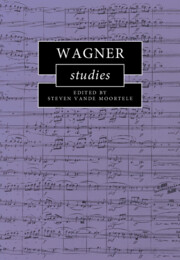Book contents
- Wagner Studies
- Cambridge Composer Studies
- Wagner Studies
- Copyright page
- Contents
- Figures
- Tables
- Music Examples
- Notes on Contributors
- Introduction: Analysing Wagner
- Part I Orientations
- Part II Form, Drama and Convention
- 3 Wagner and the Uses of Convention? La solita forma from Die Feen through Lohengrin
- 4 Elsa, Ortrud, the Grail and the Forbidden Question: Formal Functions and Rotational Form in Lohengrin
- 5 Scena, Form and Drama in Act 1 of Die Walküre
- Part III Time, Texture and Tonality
- Part IV Reception
- Bibliography
- Index
4 - Elsa, Ortrud, the Grail and the Forbidden Question: Formal Functions and Rotational Form in Lohengrin
from Part II - Form, Drama and Convention
Published online by Cambridge University Press: 17 April 2025
- Wagner Studies
- Cambridge Composer Studies
- Wagner Studies
- Copyright page
- Contents
- Figures
- Tables
- Music Examples
- Notes on Contributors
- Introduction: Analysing Wagner
- Part I Orientations
- Part II Form, Drama and Convention
- 3 Wagner and the Uses of Convention? La solita forma from Die Feen through Lohengrin
- 4 Elsa, Ortrud, the Grail and the Forbidden Question: Formal Functions and Rotational Form in Lohengrin
- 5 Scena, Form and Drama in Act 1 of Die Walküre
- Part III Time, Texture and Tonality
- Part IV Reception
- Bibliography
- Index
Summary
Recent studies applying William Caplin’s form-functional theory to Richard Wagner’s music have focused on Das Rheingold and later music dramas. However, his earlier Lohengrin, the final work he titled ‘romantische Oper’, proves an ideal candidate for such a study, since it still retains certain conventions (such as subtly disguised ‘numbers’ and a fairly clear harmonic palette) while pushing the boundary on others (such as scenes built as ‘dialogue cycles’ and pervasive use of diminished-seventh harmonies). This study first focuses on the principal Leitmotivs of the work, those associated with Elsa, Ortrud, the Grail and the Frageverbot (forbidden question), examining their theme types and loosening features, then exploring their transformations in different appearances throughout the opera – particularly Elsa’s motive. It then considers selected passages constructed in ‘rotational form’, in which one or more of these leitmotivs are used as the backbone for the cyclic form.
Keywords
- Type
- Chapter
- Information
- Wagner Studies , pp. 67 - 92Publisher: Cambridge University PressPrint publication year: 2025

